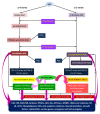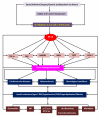Transgenic fat-1 mouse as a model to study the pathophysiology of cardiovascular, neurological and psychiatric disorders
- PMID: 20042103
- PMCID: PMC2811702
- DOI: 10.1186/1476-511X-8-61
Transgenic fat-1 mouse as a model to study the pathophysiology of cardiovascular, neurological and psychiatric disorders
Abstract
Polyunsaturated fatty acids (PUFAs) form an important constituent of all the cell membranes in the body. PUFAs such as arachidonic acid (AA), eicosapentaenoic acid (EPA) and docosahexaenoic acid (DHA) form precursors to both pro-inflammatory and anti-inflammatory compounds. Low-grade systemic inflammation occurs in clinical conditions such as insulin resistance, hypertension, type 2 diabetes mellitus, atherosclerosis, coronary heart disease, lupus, schizophrenia, Alzheimer's disease, and other dementias, cancer and non-alcoholic fatty liver disease (NAFLD) that are also characterized by an alteration in the metabolism of essential fatty acids in the form of excess production of pro-inflammatory eicosanoids and possibly, decreased synthesis and release of anti-inflammatory lipoxins, resolvins, protectins and maresins. We propose that low-grade systemic inflammation observed in these clinical conditions is due to an imbalance in the metabolism of essential fatty acids that is more in favour of pro-inflammatory molecules. In this context, transgenic fat-1 mouse that is designed to convert n-6 to n-3 fatty acids could form an ideal model to study the altered metabolism of essential fatty acids in the above mentioned conditions. It is envisaged that low-grade systemic inflammatory conditions are much less likely in the fat-1 mouse and/or these diseases will run a relatively mild course. Identifying the anti-inflammatory compounds from n-3 fatty acids that suppress low-grade systemic inflammatory conditions and understanding their mechanism(s) of action may lead to newer therapeutic strategies.
Figures
References
Publication types
MeSH terms
Substances
LinkOut - more resources
Full Text Sources
Other Literature Sources
Medical
Molecular Biology Databases
Research Materials




